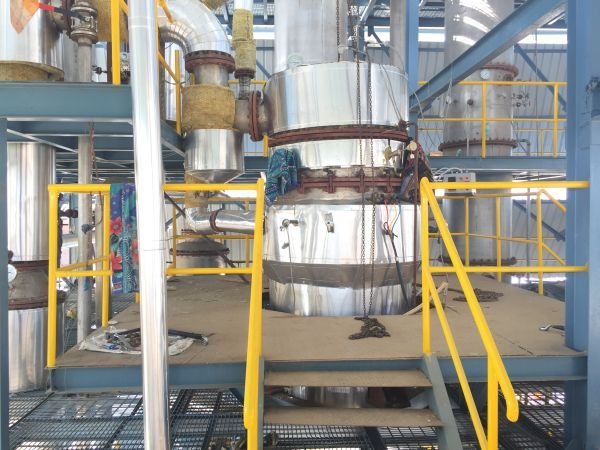Introduction
Trimethylolpropane (TMP) is a versatile organic chemical compound with three hydroxyl (-OH) groups, making it a triol. This colourless, crystalline solid serves as a crucial intermediate in the production of various industrial resins, including alkyd resins used in paints and coatings, polyurethane foams and elastomers, and synthetic lubricants. Its tri-functionality allows for extensive cross-linking in polymers, resulting in materials with enhanced durability, chemical resistance, and thermal stability. TMP derivatives are also utilized in the synthesis of adhesives, surfactants, and textile auxiliaries. Its unique molecular structure makes it a fundamental building block in numerous industrial applications requiring robust and high-performance materials.
The trimethylolpropane (TMP) market is experiencing steady growth, primarily driven by the robust demand from the paints and coatings industry, where TMP is a key component in alkyd resins that provide durability and weather resistance. The increasing construction activities and infrastructure development globally contribute significantly to this demand. Furthermore, the growing application of polyurethane in various sectors, including automotive, furniture, and construction for foams, elastomers, and adhesives, also fuels the consumption of TMP. The demand for high-performance synthetic lubricants, where TMP esters offer superior thermal stability and viscosity properties, is another significant driver. The shift towards waterborne and high-solids coatings, driven by environmental regulations aimed at reducing volatile organic compound (VOC) emissions, necessitates specific grades of TMP and its derivatives, creating new market opportunities. The increasing focus on bio-based chemicals is also leading to research and development in producing TMP from renewable resources, which could further drive market growth in the long term. The versatility of TMP as a triol, enabling the creation of polymers with tailored properties for diverse applications, ensures its continued importance across various industrial sectors.
Project Scope and Overview
IMARC Group’s report, titled “Trimethylolpropane Manufacturing Plant Project Report 2025: Industry Trends, Plant Setup, Machinery, Raw Materials, Investment Opportunities, Cost and Revenue,” provides a complete roadmap for setting up a trimethylolpropane manufacturing plant. This report delivers a structured analysis of the technical processes, equipment requirements, raw material sourcing, quality assurance, and economic feasibility for establishing a plant.
Manufacturing Process and Technical Workflow
This report offers detailed information related to the process flow and the unit operations involved in a trimethylolpropane manufacturing plant project. Moreover, information related to raw material requirements and mass balance has been provided in the report with a list of necessary technical tests as well as quality assurance criteria.
Aspects Covered
- Product Overview
- Unit Operations Involved
- Mass Balance and Raw Material Requirements
- Quality Assurance Criteria
- Technical Tests
Request for Sample Report: https://www.imarcgroup.com/trimethylolpropane-manufacturing-plant-project-report/requestsample
Infrastructure and Setup Requirements
This section presents a comprehensive analysis of key considerations involved in establishing a trimethylolpropane manufacturing plant. It covers critical aspects such as land location, selection criteria, strategic significance of the site, environmental impact, and associated land acquisition costs. In addition, the report outlines the proposed plant layout along with the primary factors influencing its design. Furthermore, it provides detailed insights into various operational requirements and expenditures, including those related to packaging, utilities, machinery, transportation, raw materials, and human resources.
- Land, Location and Site Development
- Plant Layout
- Machinery Requirements and Costs
- Raw Material Requirements and Costs
- Packaging Requirements and Costs
- Transportation Requirements and Costs
- Utility Requirements and Costs
- Human Resource Requirements and Costs
Browse the Full Report with the Table of Contents: https://www.imarcgroup.com/trimethylolpropane-manufacturing-plant-project-report
Financial Projections and Economic Viability
This section provides a comprehensive economic analysis for establishing a trimethylolpropane manufacturing plant. It encompasses a detailed evaluation of capital expenditure (CapEx), operating expenditure (OpEx), taxation, and depreciation. Additionally, the report includes profitability analysis, payback period estimation, net present value (NPV), projected income statements, liquidity assessment, and in-depth examinations of financial uncertainty and sensitivity parameters.
- Capital Investments
- Operating Costs
- Expenditure Projections
- Revenue Projections
- Taxation and Depreciation
- Profit Projections
- Financial Analysis
Key Considerations for Plant Design and Operations:
Production Capacity:
The selection of machinery and the design of the plant layout should be aligned with the intended scale of production, which may vary from small-scale operations to large industrial facilities. This alignment ensures optimal utilization of space, resources, and production capabilities.
Automation Levels:
The degree of automation should be adjusted based on factors such as labor availability, budget constraints, and the level of technical expertise. Options may range from semi-automated systems to fully automated solutions, allowing for flexibility in capital investment and operational efficiency.
Location Adaptation:
Plant location should be strategically selected to align with local market demand, ensure proximity to raw material sources, leverage available labor, and comply with regional regulatory requirements. These factors contribute to improved operational efficiency and cost optimization.
Product Flexibility:
The plant should be equipped with processes and machinery capable of accommodating a variety of product specifications. This flexibility enables manufacturers to respond to diverse and evolving market demands effectively.
Sustainability Features:
Incorporating sustainable practices is essential. This includes the integration of renewable energy sources, implementation of efficient waste management systems, and use of energy-efficient machinery to meet environmental standards and long-term sustainability objectives.
Raw Material Sourcing:
The supply chain strategy should be customized to ensure reliable and cost-effective sourcing of raw materials. This approach should consider client-specific requirements and regional supply dynamics to maintain consistent production and manage input costs.
About Us:
IMARC Group is a leading global market research and management consulting firm. We specialize in helping organizations identify opportunities, mitigate risks, and create impactful business strategies.
Our expertise includes:
- Market Entry and Expansion Strategy
- Feasibility Studies and Business Planning
- Company Incorporation and Factory Setup Support
- Regulatory and Licensing Navigation
- Competitive Analysis and Benchmarking
- Procurement and Supply Chain Research
- Branding, Marketing, and Sales Strategy
Contact Us:
IMARC Group
134 N 4th St. Brooklyn, NY 11249, USA
Email: [email protected]
Tel No:(D) +91 120 433 0800
United States: +1-631-791-1145





Comments